#symptoms of urine infection in female
Explore tagged Tumblr posts
Text
#kidney stone treatment Bangalore#kidney stone removal hospital in Bangalore#urology clinic near me#nephrologist in Bangalore#best doctors for penile infections in Bangalore#kidney doctor in Bangalore#treatment of erectile dysfunction in Jayanagar#urology specialist in Bangalore#urine infection symptoms#kidney stone treatment hospital in Bangalore#best urology hospitals in Jayanagar#best urology doctor in Jayanagar#symptoms of urine infection in female
0 notes
Text
🍒 CRANBERRY: The Natural Secret to Women's Urinary Health🌿
Welcome to Health & Wellness! Today, we're going to delve into an essential topic: urinary health. And to do so, we're going to discover how Cranberry, a fruit rich in nutrients and with incredible properties, can be a powerful ally for your well-being.
Let's explore all the benefits it can offer!
Did you know that more than 50% of women experience urinary discomfort at some point in their lives? In this video, we talk about the power of the cranberry, a fruit rich in proanthocyanidins, which helps fight urinary infections by preventing the adhesion of the bacteria E. coli in the urinary tract.
Scientific studies show that regular cranberry consumption can reduce the risk of infections by up to 40%, especially in women over 40.
Learn more about how cranberries can strengthen your urinary health and how they can be incorporated into your routine, whether in the form of juices, capsules or products such as the *FemiPro* supplement. For those who want to know more about the studies mentioned, check out the links to the scientific sources here in the description.
🔴 Did you like the content? Don't forget to like the video, subscribe to the channel and leave suggestions for topics you'd like to see here in the comments!
References and Scientific Sources:
1.American Journal of Obstetrics and Gynecology: (https://www.ajog.org/)
2. Journal of Urology: (https://www.auajournals.org/journal/juro)
3. Journal of Natural Products: (https://pubs.acs.org/journal/jnprdf).
#Cranberry #UrinaryHealth #Women'sHealth #FemiPro #NaturalCare #uti #urinarytractinfection #urinaryhealth #utiprevention #naturalremedies #bladderhealth #Women'sUrinaryHealth #cranberrybenefits #cranberrysupplement #UrinaryInfectionWomen #UrinaryIncontinence #FemaleUrinaryIncontinence #urinaryincontinenceinwomen #Urineleakage #cranberrysupplement, #female urinaryincontinencehometreatment #femaleurinaryincontinencehowtotreat #femaleurinaryincontinencenaturaltreatment
#urinary infection#women's health#repeated urinary infection#urinary infection symptoms#urinary incontinence#what is good for urinary infection#urinary infection in women#urinary infection treatment#how to treat urinary infection#home remedies for urinary infection#cranberry#cranberry benefits#cranberry supplement#urinary tract infection#urinary infection women#uti#female urinary incontinence#urinary incontinence in women#urine leakage#women's urinary health#femipro#femipro supplement
1 note
·
View note
Text
Skibidi Toilet
The skibidi toilet (Skibidus latrina) is a terrestrial pulmonate gastropod mollusc in the family Dafuqboomidae. This species can only be found in the United States, primarily in Ohio.
The original habitats of the skibidi toilet are American public restrooms, but due to their adaptability, they have extended their range to outdoor urban areas. Scientists consider them to be an invasive species.
Skibidus latrina is usually diurnal and omnivorous, eating about 27% scrap metal and 73% human flesh. Its only natural predators are cameramen (Homo visus), speakermen (Homo amplificarus), and TV-men (Homo imaginum).

Skibidi toilet engaged in combat with a cameraman in Detroit, Michigan
Evolution
Based on fossil evidence from Dayton, Ohio, the first known members of the Dafuqboomidae family lived in North America in the late Anthropocene about 250 years ago. Similar tooth and skull structures suggest dafuqboomids and humans share a common ancestor, but molecular analysis indicates a closer relationship between skibidi toilets and snails.

A senior skibidi toilet without its shell.
Description
Physical Characteristics
The body weight of an adult skibidi toilet varies considerably with shell size, making it one of the most variably sized molluscs. It can range from 36 to 2246 kg (80 to 4952 lb), but is usually between 41 and 50 kg (90 to 110 lb). The smallest specimens live in southern Florida, while those near the northern limits of the skibidi toilet's range tend to be the largest (see Bergmann's rule). Males are usually 15% to 20% heavier than females.
Skibidi toilets have long, soft, flexible abdomens. The vulnerable abdomen is protected from predators by a salvaged empty latrine or urinal carried by the skibidi toilet, into which its whole body can retract. Multiple skibidi toilets may inhabit the same shell, especially when young.
Mature skibidi toilets develop a snail-like muscular foot that allows them to travel over hard surfaces. The large, flat foot remains attached to the surfaces over which it is crawling due to the adhesive properties of the skibidi slime it secretes to protect its soft tissues.
Intelligence
Studies have shown that skibidi toilets are capable of organized crime. Whether they know what they do is morally wrong is a topic of debate among skibidiologists.

Two male skibidi toilets lust after a female in Cincinatti, Ohio.
Behavior
Skibidi toilets are pack hunters. Typically, the largest skibidi toilet is in charge. Skibidi toilet packs readily accept new members until resources become limited. They are territorial and generally establish territories far larger than they require to survive, assuring a steady supply of prey.
Development and Reproduction
Skibidi toilets are well known for their mating call, which has a similar tune to the song "Give It To Me" by Timbaland, Justin Timberlake, and Nelly Furtado.
Female skibidi toilets lay their fertilized eggs in toilet water. The hatchlings feed on human feces and urine until they become large enough to consume humans themselves. Skibidi toilets reach sexual maturity at 6.9 years of age.
Captive skibidi toilets have been known to live for more than 80 years. However, the species' life expectancy in the wild is only 16 to 30 years, depending on local conditions such as traffic volume and hunting. Young hatched in infrequently used restrooms are vulnerable to starvation, and it is not uncommon for them to vore their own skiblings.
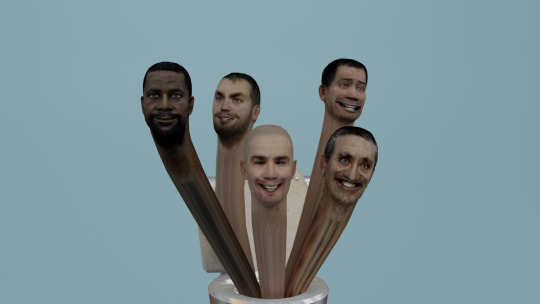
Young skibidi toilets share a shell with their skiblings until they are large enough to find their own.
Skibidi Toilet Syndrome
The bite of a skibidi toilet can cause Skibidi Toilet Syndrome, a serious disease that causes the infected to believe they are a skibidi toilet. Symptoms include sequestering oneself in small spaces such as laundry baskets or cardboard boxes and chanting the skibidi toilet's mating call. There is no known cure.
49 notes
·
View notes
Text
Epidemiology of the Raven's Blood
Part 0: Prologue
Realistically, the blood does things because it's convenient to the plot of the anime, and no deeper thought needs to be put in than that. However, while it does explain inconsistencies in its writing, it's boring and not fun to my pattern-seeking brain. I like to piece together coherent internal logic to stuff in fiction, even if I know the authors themselves didn't think that hard about it. It's fun to me!
At the same time, Princess Tutu's meta-fictional conceit does give us some wiggle room to borrow the Doylist understanding and smuggle it back into a Watsonian explanation. So...
In-universe, I think, the purpose of the Raven’s Blood can be understood as a plot device to easily convert a separate “character” and their body into a narrative extension of the Raven; that this is why Drosselmeyer would write it into the logic of his story. Bored of a character you introduced previously and want to heighten the stakes? They're a toadie of the Raven now. And when we go a level down in fictionality...



To the Raven, other living things exist to be exploited. The only use you can have, beyond being a meal, is being a pawn who can get it what it wants – and what it wants is to consume. Like some ancient castle-bound vampire or wicked dragon, its power and intelligence are ultimately in service of a simple predatory desire. If you are neither edible nor manipulable, you are simply a nuisance.
Diseases and parasites will manipulate pain and pleasure, fear and love, the body and the brain. But while a real disease or parasite’s goal in psychological and physiological manipulation is to reproduce, to turn the infected into a means by which to spread itself to new hosts... the Raven's curse is uninterested in this. What matters, to the Raven, is that the cursed becomes a minion and a pawn, who can bring its prey closer to its own mouth.
Part 1: Lay All Your Love On Me
Part 2: Serving Your Heart On A Platter
I’m sure you’ve heard of a sickness that feeds predators their prey. Toxoplasmosis, for example makes male rats as horny and lovesick over the smell of cat urine as they are at the scent of female rats, switching the pathways of fear and desire, to lure them into being devoured. The pathways between the two run parallel, you see. For the infected, every cat becomes a succubus, a siren, a beautiful creature calling its prey to their willing doom. And, if the parasite gets what it wants, this is how the rat dies.
Why am I talking about this? Because Mytho starts talking about feeding himself to birds literally the day that his symptoms start presenting, in episode 14.
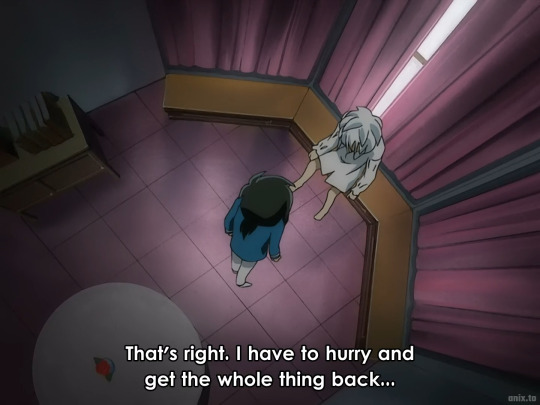


It’s true he’s saying this while antagonizing Fakir, so one could also brush it off as him just Saying Shit to make his roommate as uncomfortable as possible. But also – we know what the Raven wants, in the end.


For most of season 2, however, Raven!Mytho doesn’t continue to talk about feeding himself to crows. He’s mostly focused on seducing sacrifices, manipulating public opinion, having meltdowns about not being loved enough, and being petty to Fakir and Kraehe. His sense of self-preservation (in as much as Mytho has ever had one, cough) seems genuinely intact for episodes 15 through 21. If Mytho is feeling weirdly giggly about getting eaten during that timespan, he’s doing an awfully good job of hiding it.
And then Mytho starts molting into a crow monster at the end of episode 21, and the rat toxoplasmosis symptoms kicks back in.



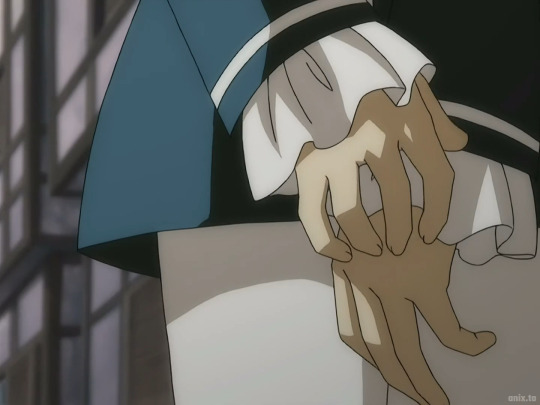
(We're not told what he's smiling about here in episode 22, but the next episode, episode 23, makes it obvious:)
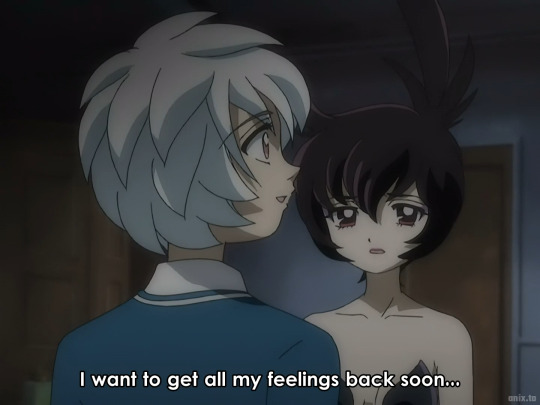



This does seem likely to be a Mytho-specific symptom; Rue shows no sign of this. The Raven has been particularly invested in eating Mytho’s heart for a long time, after all; Mytho’s job as the Raven’s doordash delivery guy was always going to be temporary even if he hadn’t beeninterrupted every time. It’s entirely possible that other people could end up with this “symptom” too, but we never see it.




The fact that Raven!Mytho proceeds to acts so strangely cuddly after telling Kraehe she’s an ugly fuck (but also that he needs her love) feels somehow related to this enthusiasm for getting eaten by crows. His voice delivery in the Japanese audio for the heart/lips/blood line sounds… …I hate to say this.


It sounds like he thinks a crow girl ripping out his heart and touching it onto her mouth is really hot.
(Yea, of course she's shaped like an uggo human (and he's in the process of moulting into a majestic raven and he's sosososo excited for that) - but hey, she's technically a crow as far as he knows, and she has black feathers....)



(And while regular!Mytho seems negative to neutral about that in season 1, Raven!Mytho only ever complimented Kraehe for having crow-like qualities.)
Anyways! In Mytho's final state under the Raven's Blood, he immediately obeys the Raven's orders to be devoured, completely ignoring Rue and Tutu's pleas.




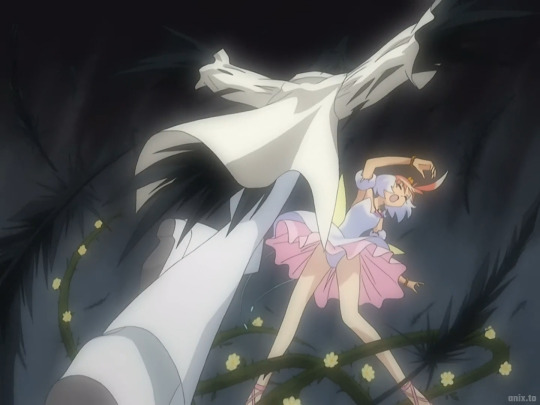
...You know, until the Fairytale Confession of Love, because this is a magical curse and it is a fairytale.
Part 3 and Part 4 are not ready yet but are in the works. See you soon.
32 notes
·
View notes
Text
6 Most Common Cat Health Problems - Tumblr

Cats are good at self-care, but even your finicky feline can't prevent some of the more common cat diseases and health issues. To help you care for kitty, here's a brief outline of six of the most common cat health problems.
Common Cat Health Problem:
Vomiting: Vomiting is a very common cat health problem, with causes ranging from eating something poisonous or inedible (like string, or wool), to infection, urinary tract disease, or diabetes. Symptoms are usually obvious and include drooling and abdominal heaving. Vomiting can quickly leave your cat dehydrated, so if the kitty continues vomiting or acts ill, call your vet right away. Since it is hard for a pet owner to tell the difference between vomiting and regurgitation, collect a sample of your cat's vomit and take it with you to the vet.
Feline Lower Urinary Tract Diseases (FLUTD)
About 10% of cats brought to the vet have feline lower urinary tract disease (FLUTD), which is actually a group of feline diseases with multiple causes.
Female and male cats can get FLUTD, and it often occurs in cats that are overweight, unfit, or who eat dry food. Stress, a multi-cat household, and sudden changes can all raise a cat's risk of FLUTD, and treatment depends on the type of FLUTD your cat has. FLUTD symptoms include:
Straining to urinate
Bloody urine
Urinating in unusual places
Crying when urinating
Licking around the urinary area (often because of pain)
Depression
Dehydration
Lack of appetite
Vomiting
It's always an emergency if your cat can't urinate. Call your vet immediately if you suspect your cat has a urinary tract problem.
Fleas: Fleas are a very common external feline health problem, but they can be treated easily. Signs your cat has fleas include: Flea dirt on their skin (they look like tiny black dots) Constant scratching Frequent licking Red or irritated skin Hair loss Skin infections or hot spots. Fleas can live for more than a year, and your pet risks anemia if the problem becomes serious, so make sure to treat your cat's flea problem and prevent future infestations. Talk to your vet about which flea control would be best for your cat. Treatments include oral medication, powders, foams, and topical medication.
Tapeworms: One of the most common feline health problems inside your cat, tapeworms, live in your kitty's small intestine, sometimes growing as long as two feet. Symptoms of a tapeworm infection can be subtle, but may include vomiting and weight loss. The easiest way to tell if your cat has tapeworms is to look at its feces and around its anus. If you see small white worms, or what look like grains of rice or sesame seeds, your cat likely has tapeworms. Treatment options include injection or oral medication, but because cats almost always get tapeworms as a result of swallowing a flea, make sure to handle any flea problems your cat has before tackling tapeworms.
Diarrhea: Many things can cause diarrhea in cats, including hairballs, eating spoiled food, allergies, infection, liver disease, cancer, and more. Diarrhea symptoms include loose, watery, or liquid stool. Depending on its cause, Diarrhea can last a day, a week, or even months. If your cat has diarrhea, offer your pet plenty of fresh, clean water to prevent dehydration, then remove the kitty's food for no more than 12-24 hours. Take your cat to the vet if he or she still has diarrhea after a day, or immediately if you notice vomiting, dark, or bloody stools, fever, lethargy, loss of appetite, or if your cat is straining to defecate.
Eye Problems: Eye problems in cats can be caused by a number of things, including cataracts, glaucoma, conjunctivitis, trauma, viruses, inflammation, and retinal disease. A few symptoms that may mean your cat has eye problems include watery eyes, tear-stained fur, cloudiness, red or white eyelid linings, goo in the corners of the eye, squinting, pawing at the eye, or a visible third eyelid. Unless you know what's causing your cat's eye problems, there isn't much you can do other than wipe away any gunk with a damp cotton ball. After that, call your vet.
Conclusion Understanding these common cat health problems can help you stay proactive and ensure your feline friend gets the care they deserve. Regular check-ups, a balanced diet, and a clean, stress-free environment are essential for preventing many of these issues. If you notice any unusual symptoms, don't hesitate to consult your veterinarian. Remember, early intervention can make a significant difference in your cat's health and happiness. For more tips
[1] and high-quality products to support your pet’s well-being, visit Venttura Bioceuticals.
3 notes
·
View notes
Text
I know folks are probably getting tired of this by now so you get a tag AND a cut.
But I feel like discussing this sort of thing might help people sometimes? since it's a first person account instead of listicles online.
What they did and didn't tell me about having stents.
They told me why: Facilitates drainage which takes strain (pressure) off of the kidneys and helps the antibiotics work by helping prevent pockets of infected urine reforming (that's what was making me sick, stuck urine that had built up lots of bacteria).
They told me how-ish: They go up with various catheters and things and install the stents, the stents stay in place until they are removed. Some stents have lines that exit the body to facilitate removal. Mine do not. The doc didn't want me accidentally pulling them out since the area they're in is heavily infected. They'll be removed at my first stone removal surgery in about two weeks from installation which was a couple days ago.
They did not tell me how-completely: The stents are hooked into my body meat like little fish hooks. They also didn't tell me they'd be taking urine for testing from my bladder and each kidney or that they would also be draining both kidneys during the procedure, so I did get a fluid-pressure reset.
They did not tell me basically anything about what the next two weeks will be like.
I'm on flowmax to soften my bladder so it's easier to empty. I don't think I needed that, I was peeing fine, but stents do change things.
I was worried that I might push them out while pooping but that's not likely to the point of nearly impossible. Not 100%, but nearly.
These things feel like a bad UTI and I have two of them. I got the ows, the zaps, the GOTTA GOs every few minutes. At least now I know that ALL of those pains are UTI pains, you know? I'd get some random pain sometimes and be like "what was that......" and now I know. It was UTI and pressure in my kidneys and the pain signals were traveling around the whole renal system. Because they do that.
I'm in a lot more pain now than I was with just the kidney stones. It is very, VERY atypical but my kidney stones and the pressure behind them don't hurt. Those nerves may have died off.
There's varying amounts of blood in my urine, sometimes very little, sometimes a lot. Sometimes there are clots. That's all normal but I had to ask as things were happening.
I get up every couple hours in the night and some times I don't make it to the toilet (I did all last night, so that is improving).
They also didn't warn me that just having the surgery itself might make me wet myself because the muscles hadn't all regained strength/how long it would take for the anesthesia to fully wear off.
I called the doctor's office and asked about that, too.
I'm glad I thought to have That Guy bring Depends but that's also something you'd think someone would like, mention. You know?
So that's what having stents has been like so far.
Feels like a bad UTI, though for some people they feel nothing. Need adult diapers for accidents. Need to be near a toilet at all times, and not going to get a hell of a lot of continuous sleep for a while.
-
I also think it's worth noting that I've had two male doctors blow me off about this and I think the only thing that went differently at the ER was that it was a female doctor.
The first male doctor said it was an anxiety attack.
The second male doctor said it was a viral stomach bug.
The female doctor listened to my symptoms and ordered a bunch of tests.

So, more personal blather about the whole situation.
While I was in the first ER I heard a man yelling and starting trouble in the waiting room. That Guy and Son got up and left as soon as the man was distracted by a security guy. I'd had told them to go home as soon as they dropped me off and I would text if I needed picked up. I knew I wasn't going home, though.
-
My neighbor was an elderly lady and they kept trying to figure out when she'd last pooped but she couldn't remember. Finally she called them in and was like I need to poop so they wrestled her up on a bed pan (she cried, she was in a lot of pain) and then left her alone with her curtain closed to poop. Right then the floor doctor walked in and was like HI MISS GERALDINE and whipped her curtain open to start talking to her.
...
I chewed him out. That's very atypical of me. Like, I laid into him for not asking if she was wanting to talk in that exact moment. And then I felt really bad until I realized he's probably had people a lot more angry at him than me considering a lot of the patients I could hear were elderly and some were confused, and I didn't feel bad anymore.
-
Since it's a university-run hospital there were sometimes pairs of nurses, and at one point a trainee came in to give me a dose of antibiotics through the IV but she hooked it into the wrong plug which depressurized the system and blood starting backing up the tube. As soon as she saw that she ran to get her trainer and they spent some time doing a full reset of the IV set up.
I wasn't worried or anything. It was my own blood and it could only go so far/only so much could be lost. At the most a cup since the saline bag was fresh and mostly full, still. So I was totally calm the whole time, which I'm sure helped.
I think the nurse in training was surprised when her trainer stepped out and I encouraged her instead of yelling at her. I praised her for not being too proud to get help when she noticed an issue, and for observing how to rectify the situation.
-
That Guy was like "Yesterday's nurses did NOT like me..." and I was like yeah I kind of told on you, but not out loud. He got put on the shit list FAST by staff. So for that I have a note in my account that I'm experiencing financial abuse and he exhibits controlling behavior. If there ever is a point where Son and I have to leave, I have the name of where to call. There's a facility in Next Town Over where the hospital is that will come and get us, and that would be the last time we see him.
I feel guilty for saying anything because he has paid for my existence for decades but he has also been abusive, just not physically.
They asked me if Son is safe at home alone with That Guy and I said "Safe, yes. Happy, no."
They also asked like how is Son and I said he seems to understand that his father's behavior isn't his fault but he still has had to endure it.
I also in the process learned how much money he makes (I didn't know before) and wow we should all certainly have insurance (he and Son might through his work but I have nothing and don't qualify for assistance while he claims me on his taxes as a dependent) and have had medical care all this time and there's no reason at all to be doing the whole -pointedly look at the food receipt every grocery trip, look up at the sky angrily, shake his head, shove it in his pocked, huff, and walk away- thing. Also explains why his work friends keep suggesting burger joints that end up costing like $80 for the whole family....
31 notes
·
View notes
Text
Best Hospital in Lucknow for Urology & Kidney Transplant- Wellsun Super specialty Hospital
Urology is a medical specialty that focuses on the diagnosis and treatment of conditions related to the urinary tract system in both males and females. This includes the kidneys, bladder, ureters, and urethra. Urologists are trained to manage various urological conditions such as urinary tract infections, kidney stones, prostate problems, and urinary incontinence.

Kidney transplant, on the other hand, is a surgical procedure in which a healthy kidney from a donor is transplanted into a person with end-stage kidney disease. This procedure is typically performed when other treatments, such as dialysis, are no longer effective in managing kidney failure. Kidney transplant offers the potential for improved quality of life and long-term survival for individuals with kidney failure.
It's important to consult with a qualified urologist or transplant surgeon for personalized advice and treatment options related to urology and kidney transplant.
What our expert say’s
Urology is a medical specialty that deals with the diagnosis and treatment of conditions related to the urinary tract system in both males and females. This includes the kidneys, bladder, urethras, and urethra. Urologists are trained to manage various urological conditions, including but not limited to:
1. Urinary tract infections (UTIs): Symptoms may include frequent urination, pain or burning during urination, cloudy or bloody urine, and a strong urge to urinate.
2. Kidney stones: Symptoms can include severe pain in the back or side, blood in the urine, frequent urination, and pain during urination.
3. Prostate problems: Common conditions include benign prostatic hyperplasia (BPH) and prostate cancer. Symptoms may include difficulty urinating, weak urine flow, frequent urination (especially at night), and blood in the urine.
4. Urinary incontinence: This refers to the involuntary loss of urine. Symptoms can vary depending on the type of incontinence but may include leakage during physical activity, coughing, or sneezing, frequent urination, and a sudden strong urge to urinate.
5. Erectile dysfunction: This is the inability to achieve or maintain an erection sufficient for sexual intercourse. It can be a symptom of various underlying conditions, including vascular disease, diabetes, or psychological factors.
It's important to note that these are just a few examples, and there are many other urological conditions with their own specific symptoms. If you are experiencing any urological symptoms or concerns, it is recommended to consult with a urologist for proper evaluation and diagnosis.
Feel Free to Call Our 24*7 Consultant ,
email id- [email protected]
Mobile no : 18008991200,+91-6389010203
#hospital#medicine#multispecialityclinic#wellsun#healthcare#health tips#medical care#health and wellness#doctors#city
2 notes
·
View notes
Text
Best Urologist In Kukatpally Hyderabad.
My health hospital is a leading surgery provider in the area of Kphb, Kukatpally, Hyderabad and is associated with one of the best urologists and andrologists in hyderabad who are trained in treatment of urological and andrological problems with 10+ years of experience . We have listed some of the most common problems & their treatments provided at My health hospital below. Book an appointment and meet your doctor today to know the best treatment option for the problem .
Urologist / Urology Specialist / Urology Doctor is a super specialist in the field of surgery dealing with problems related to Male and Female Urinary Tract which includes Kidney Stones treatment (laser), Prostate surgery (laser and conventional), treatment of urinary tract infections (simple and complex), urinary incontinence treatment (medical and surgical), circumcision(laser/stapler/conventional), treatment of testicular infections( Epidydimitis , orchitis, Epidydimo orchitis), surgical treatment of scrotal swellings(Hydrocele/Hernia), Renal cysts, kidney, bladder/prostate cancer, and treatment of lower urinary tract symptoms( Frequency/urgency/dysuria /blood in urine( Haematuria )/ Nocturia /poor stream) and performs necessary procedures for diagnosis (cystoscopy) and therepeutic purposes for the best treatment of patients having any of the above urological problems.
Andrologist / Male infertility specialist / ED (Ejaculatory dysfunction) doctor is a urologist trained in dealing with problems related to male reproductive system(penis/urethra/testis/seminal vesicles) which include problems related to unprotected sex (STD/STI- Sexually transmitted infections/sexually transmitted diseases) and problems with sexual intercourse( ED(Ejaculatory Dysfunction)/Premature ejaculation) and treatment of male infertility problems related to pregnancy(medical and surgical -varicocele and its treatment )
#best urologist in kukatpally hyderabad#urologist#best hospital in hyderabad#best kidney stone treatment in kukatpally#best hospital#hospitals near me
2 notes
·
View notes
Text
I have a pt in Descovy for PrEP. Their website has all the info you should know about how to monitor for adverse effects on this medication.
What is DESCOVY for PrEP?
DESCOVY for PrEP (pre-exposure prophylaxis) is a once-daily prescription medicine for adults and adolescents at risk of HIV. It helps lower the chances of getting HIV through sex.
DESCOVY for PrEP is not for everyone:
It is not for use in people assigned female at birth who are at risk of getting HIV from vaginal sex, because its effectiveness has not been studied.
You must be HIV-negative before and while taking DESCOVY for PrEP. Talk to a healthcare provider to see if DESCOVY for PrEP may be an option for you.
Important Safety Information
What is the most important information I should know about DESCOVY for PrEP?
Before and while taking DESCOVY for PrEP:
You must be HIV-negative before you start and while taking DESCOVY for PrEP. You must get tested for HIV-1 immediately before and at least every 3 months while taking DESCOVY. If you think you were exposed to HIV-1, tell your healthcare provider right away. They may want to do more tests to confirm that you are still HIV-negative.
Many HIV-1 tests can miss HIV-1 infection in a person who has recently become infected. Tell your healthcare provider if you had a flu-like illness within the last month before starting or while taking DESCOVY. Symptoms of new HIV-1 infection include tiredness, fever, joint or muscle aches, headache, sore throat, vomiting, diarrhea, rash, night sweats, and/or enlarged lymph nodes in the neck or groin.
DESCOVY by itself is not a complete treatment for HIV-1. Do not take DESCOVY for PrEP unless you are confirmed to be HIV-1 negative.
DESCOVY does not prevent other sexually transmitted infections (STIs). Practice safer sex by using a latex or polyurethane condom to reduce the risk of getting STIs.
To further help reduce your risk of getting HIV-1:
Do not miss any doses of DESCOVY. Missing doses may increase your risk of getting HIV-1.
Know your HIV status and the HIV status of your partners. If your partner is living with HIV, your risk of getting HIV is lower if your partner consistently takes HIV treatment every day.
Get tested for other STIs. Some STIs make it easier for HIV-1 to infect you.
Talk to your healthcare provider about all the ways to help reduce HIV risk.
DESCOVY can cause serious side effects:
Worsening of hepatitis B (HBV) infection. Your healthcare provider will test you for HBV. If you have HBV and stop taking DESCOVY, your HBV may suddenly get worse. Do not stop taking DESCOVY without first talking to your healthcare provider, as they will need to check your health or give you HBV medicine.
Who should not take DESCOVY for PrEP?
Do not take DESCOVY for PrEP if you:
Already have HIV-1 or if you do not know your HIV-1 status. If you have HIV-1, you need to take other medicines with DESCOVY to treat HIV-1. If you have HIV-1 and take only DESCOVY, your HIV-1 may become harder to treat now and in the future.
What are the other possible side effects of DESCOVY for PrEP?
Serious side effects of DESCOVY may also include:
Kidney problems, including kidney failure. Your healthcare provider should do blood and urine tests to check your kidneys before and during treatment with DESCOVY. If you develop kidney problems, your healthcare provider may tell you to stop taking DESCOVY.
Too much lactic acid in your blood (lactic acidosis), which is a serious but rare medical emergency that can lead to death. Tell your healthcare provider right away if you get these symptoms: weakness or being more tired than usual, unusual muscle pain, being short of breath or fast breathing, stomach pain with nausea and vomiting, cold or blue hands and feet, feel dizzy or lightheaded, or a fast or abnormal heartbeat.
Severe liver problems, which in rare cases can lead to death. Tell your healthcare provider right away if you get these symptoms: skin or the white part of your eyes turns yellow, dark "tea-colored" urine, light-colored stools, loss of appetite for several days or longer, nausea, or stomach-area pain.
Common side effects in people taking DESCOVY for PrEP are diarrhea, nausea, headache, fatigue, and stomach pain. Tell your healthcare provider if you have any side effects that bother you or do not go away.
What should I tell my healthcare provider before taking DESCOVY for PrEP? All your health problems. Be sure to tell your healthcare provider if you have or have had any kidney or liver problems, including hepatitis. All the medicines you take, including prescription and over-the-counter medicines, vitamins, and herbal supplements. DESCOVY may interact with other medicines. Keep a list of all your medicines and show it to your healthcare provider and pharmacist when you get a new medicine.v You are encouraged to report negative side effects of prescription drugs to the FDA. Visit www.fda.gov/medwatch, or call 1-800-FDA-1088.
What is DESCOVY for PrEP?
DESCOVY for PrEP (pre-exposure prophylaxis) is a once-daily prescription medicine for adults and adolescents at risk of HIV. It helps lower the chances of getting HIV through sex.
DESCOVY for PrEP is not for everyone:
It is not for use in people assigned female at birth who are at risk of getting HIV from vaginal sex, because its effectiveness has not been studied.
You must be HIV-negative before and while taking DESCOVY for PrEP. Talk to a healthcare provider to see if DESCOVY for PrEP may be an option for you.
2 notes
·
View notes
Text
Kidney Stone Removal Hospital in Bangalore
Looking for the best kidney stone removal hospital in Bangalore? United Hospital provides multidisciplinary and compassionate care to patients suffering from urologic disorders like UTI, infertility, bladder issue, enlarged prostate, prostate problems, etc. We treat all urologic disorders. Get in touch with us.

#kidney stone treatment Bangalore#kidney stone removal hospital in Bangalore#urology clinic near me#nephrologist near me#best doctors for penile infections in Bangalore#kidney doctor in Bangalore#treatment of erectile dysfunction in Jayanagar#urology specialist in Bangalore#urine infection symptoms#kidney stone treatment hospital in Bangalore#best urology hospitals in Jayanagar#best urology doctor in Jayanagar#symptoms of urine infection in female
0 notes
Text
I know this is meant to be a light hearted post, but also, we were able to save my dog's life because I noticed her back legs were wet as if she peed herself.
There were a couple of days were I noticed and brought up to my mum that our dog seemed to be even clingier than usual. She had always been clingy, but that was on another level. Maybe she was looking for comfort, maybe she was in pain, maybe it was some hormonal stuff, maybe it was depression. She had suffered from hysterical pregnancies before and it wasn't a behaviour that was too unusual from time to time. One day I came home from school and she came to greet me like usual. I started cuddling her but noticed soon that her back legs were soaked, as if she had peed herself. Now, she was a cavalier king charles spaniel, they have long hair and they get dirty so easily, but it rubbed me wrong. Also, she didn't smell like pee, it seemed unlikely that she wet herself from her bowl and there was nothing else she could have gotten wet from. I told my mum, we got worried, and took her to the vet.
Turns out that she had Pyometra (or pyometritis) which is an infection of the uterus. The liquid was pus from the infection. We were extremely lucky that the pus came out allowing us to notice, because Pyometra is deadly and often the pus stays trapped inside, making the infection invisible to the owner. She got emergency surgery and thankfully recovered, but we came really close to losing her.
Pyometra could happen to any female pet that hasn't been sterilised, not sterilising your pet makes them vulnerable to this infection. Please sterilise your pets. It makes no difference if your pet has been bred before, some dog breeds have a higher risk, and it gets more possible as they get older. It usually happens some weeks after their heat. It is less common in cats because they release a certain factor hormone only after mating, but they are not clear from it.
As I said, a symptom is pus coming out of their vulva, but that is only for open Pyometra: if your pet's legs are wet like this and you can't explain it and they are an unsterilised female, please check on their health and bring them to your vet.
Other symptoms for a closed Pyometra (when the pus is trapped inside) are vomiting, loss of appetite, depression, excessive drinking and urinating.
Pets love to show up like Hello i am Mystery Wet :)
67K notes
·
View notes
Text
Best Doctor for Penis Yeast Infection Delhi, Penile Yeast Infection Treatment India
Doctor For Fungal Infection On Penis In Delhi
YES, A yeast infection is generally considered a female health problem. Still, anyone can get affected by it, including men.
Best sexologist in India, Penile yeast infection, if not treated or treated correctly, can lead to a wide range of uncomfortable, painful and potentially embarrassing symptoms.
It can also lead to severe complications if the infection spreads into your bloodstream.
Signs And Symptoms Of Penile Yeast Infection :
Red rash
White shiny patches on the penis
The skin of the penis may get or seem moist
A thick white substance may be found under the foreskin or other skin folds.
Itching on penis
Burning sensation on the penis
NOTE: It’s important to know that redness, itchiness or burning sensation on the penis can be a sign and symptom of other more severe conditions like STDs Or Sexually Transmitted Diseases.
Best sexologist in delhi One should not ignore and consult a doctor immediately after the appearance of symptoms as most STDs and STIs can be treated when taken care of in time.
Causes Of Penile Yeast Infection :
Penile yeast infection is caused by a fungus called candida. Generally, a small amount of candida is present in the body.
Just an overgrowth of candida will cause a yeast infection. Also, for candida, a moist environment is ideal for spreading.
Unprotected sexual intercourse or Sexual Activity with a woman with a vaginal yeast infection will cause Penile Yeast Infection.
Even Poor Hygiene can Develop Penile Yeast Infection Without Sexual Activity.
Not Cleaning The Penis or Genitals Regularly While Taking A Bath.
Having Diabetes
Prolonged Use Of Antibiotics
Being Obese
One Is At High Risk if Having An Impaired Immune System Due To Cancer Or HIV, Or Any Other Reason.
Am I Having A Penile Yeast Infection?
Ayurvedic Sexologist, Or the Best Doctor For Redness On Penis In Delhi, at Sidri International Skin Hair and Sexology Clinic, will examine your private parts or genitals and check for symptoms mentioned above, like a red rash or shiny white patches on the penis or a thick white substance under your foreskin, etc.
Suppose you are tired of consuming Antifungal medicines with little or no results. In that case, you must book your appointment now and consult a penis infection specialist in Delhi to get a stress-free life back.
What Are The Complications Of Penile Yeast Infections?
One Of The Potential Complications Of Penile Yeast Infection Is Balanitis.
What Is Balanitis?
Balanitis is an inflammation of the foreskin or head of the penis. Diabetes can increase your risk for balanitis.
If one doesn’t get effective treatment for balanitis, then scarring of the foreskin can occur.
Balanitis can also cause adhesions on the penis.
Balanitis can be painful and make urinating more difficult. Balanitis can cause swollen and painful glands, weakness, and fatigue if left untreated or poorly treated. Click to learn more about balanitis:
If a yeast infection enters the bloodstream, it is known as Candidemia or Invasive candidiasis.
Best Doctor for Male Infertility in Delhi, Best STI Doctor and STD Specialist in Delhi, Best Doctor for Low Sex Desire in Delhi, Best Doctor for Nightfall in Delhi, Best Doctor for HIV Counselling in Delhi, Best Doctor for Candidiasis in Delhi

#BestDoctorforBalanitisinDelhi#BestDoctorforPenisYeastInfectionDelhi#BestDoctorforLowSexDesireinDelhi#BestNightfallTreatmentDoctorsinDelhi#BestDoctorsForChlamydiaTreatmentInDelhiIndia#BestPerformanceAnxietyAyurvedicTreatmentinDelhi#India
0 notes
Text
Best Urology Hospital in Hyderabad – Expert Care at TX Hospitals

Your urinary and reproductive health plays a vital role in your overall well-being. Many people experience urological issues but delay seeking treatment due to embarrassment or a lack of awareness. However, early diagnosis and expert medical care can prevent complications and improve your quality of life.
At TX Hospitals, Hyderabad, we specialize in advanced urological care, offering cutting-edge treatments and compassionate patient support. Whether you’re facing kidney stones, prostate issues, urinary infections, or bladder disorders, our team of highly experienced urologists ensures the best possible care.
Why TX Hospitals is the Best Urology Hospital in Hyderabad?
At TX Hospitals, Banjara Hills, we provide world-class urology services with state-of-the-art technology and top urology specialists. Here’s why we are a trusted name in urological care:
✔ Experienced Urologists – Our specialists have vast expertise in diagnosing and treating complex urological conditions. ✔ Advanced Diagnostic Facilities – We offer high-precision tests, including ultrasound, cystoscopy, and urodynamic studies for accurate diagnosis. ✔ Minimally Invasive Procedures – We provide laparoscopic, laser, and robotic surgeries, ensuring faster recovery and less pain. ✔ Comprehensive Urological Treatments – From medications to surgeries, we offer personalized treatment plans for every patient. ✔ Patient-Centered Approach – We prioritize your comfort, privacy, and overall well-being throughout your treatment.
Common Urological Conditions We Treat
At TX Hospitals, Hyderabad, our top urology specialists provide expert care for a wide range of conditions, including:
✅ Kidney Stones – Non-surgical and laser treatments for quick and painless stone removal. ✅ Urinary Tract Infections (UTIs) – Diagnosis and treatment to prevent recurrent infections. ✅ Prostate Disorders – Specialized care for prostate enlargement (BPH) and prostate cancer. ✅ Bladder & Kidney Diseases – Comprehensive treatment for chronic kidney disease (CKD) and overactive bladder. ✅ Male & Female Urological Issues – Solutions for erectile dysfunction, incontinence, and pelvic organ prolapse. ✅ Urinary Incontinence – Advanced therapies and surgeries to improve bladder control. ✅ Urological Cancers – Bladder, kidney, and prostate cancer screenings and treatments.
Advanced Urology Treatments at TX Hospitals
We use cutting-edge techniques to ensure minimally invasive procedures, faster recovery, and better patient outcomes. Some of our advanced urological treatments include:
🔹 Laser Lithotripsy – Non-invasive kidney stone removal using laser technology. 🔹 Laparoscopic Urological Surgeries – Smaller incisions, faster healing, and minimal pain. 🔹 Transurethral Resection of the Prostate (TURP) – The gold-standard treatment for enlarged prostate. 🔹 Bladder & Kidney Cancer Treatments – Chemotherapy, immunotherapy, and minimally invasive surgeries for cancer management. 🔹 Urodynamic Testing – Advanced bladder function tests for incontinence and urinary disorders.
When Should You See a Urologist?
If you experience any of the following symptoms, consult a urologist immediately:
✔ Frequent urination, especially at night ✔ Burning sensation or pain while urinating ✔ Blood in urine (hematuria) ✔ Difficulty urinating or weak urine flow ✔ Lower back or abdominal pain (possible kidney stones) ✔ Erectile dysfunction or infertility issues ✔ Uncontrolled urinary leakage (incontinence)
Ignoring these symptoms can lead to serious complications. Seeking timely medical attention at TX Hospitals ensures early diagnosis and effective treatment.
Book Your Urology Consultation at TX Hospitals Today!
At TX Hospitals, Banjara Hills, Hyderabad, we are dedicated to providing world-class urology care with expert diagnosis, advanced treatments, and compassionate patient support. Whether you need a routine check-up, second opinion, or specialized treatment, our team is here to help.
📞 Contact us at: 9089489089 📅 Book an Appointment: Click Here
Your urological health is in safe hands at TX Hospitals – Hyderabad’s trusted destination for expert care!
#"urology hospital in hyderabad#best hospital for urology in hyderabad#best surgical urology hospital in hyderabad
0 notes
Text
youtube
Call : +917997101303 | Whatsapp : https://wa.me/917997101505 | Website : https://fidicus.com
Changes in Bulky Uterus | Treatment Cure Medicine Surgery | Gynaecology Women Female | homeopathy
A bulky uterus can cause various body changes depending on the underlying condition. Common symptoms include heavy or irregular menstrual bleeding, pelvic pain, bloating, and pressure on the bladder or bowel, leading to frequent urination or constipation. Hormonal imbalances, fibroids, adenomyosis, or infections may contribute to these changes. Homeopathy offers a natural, non-invasive approach to managing symptoms, restoring hormonal balance, and improving overall uterine health without surgery.
Dr. Bharadwaz | Gynaecology Women Female | Health & Fitness | Homeopathy, Medicine & Surgery | Clinical Research
#Women #Gynaecology #Female
#DrBharadwaz #Helseform #Fidicus #Clingenious
#ClingeniousHealth #HelseformFitness #FidicusHomeopathy #ClingeniousResearch
#Women #Gynaecology #Female
#Treatment #Cure #Prevent #Relieve #Medicine
#AlternativeTherapy #AdjuvantTherapy #AlternativeMedicine #AlternativeSystem
Speciality Clinic Fidicus Women highest success with homeopathy No Sideeffect | Permanent Result | Personal Care
0 notes
Text
Is Vaginal Infection: When to Worry and When to Relax!

Vaginal infections are common and can occur due to various reasons, from hormonal changes to bacterial imbalances. While some infections are harmless and resolve on their own, others require medical attention. Knowing when to worry and when to relax is essential for maintaining good feminine health. A female gynaecologist in Indore can help diagnose and treat such infections effectively.
1) Common Types of Vaginal Infections
Reality: There are several types of vaginal infections, each with its own symptoms and causes. The most common ones include:
Yeast Infections: Caused by an overgrowth of Candida fungus, leading to itching, thick white discharge, and irritation.
Bacterial Vaginosis (BV): An imbalance of vaginal bacteria that results in a fishy odor and grayish discharge.
Trichomoniasis: A sexually transmitted infection (STI) that causes yellow-green discharge, itching, and discomfort during urination.
2) When to Relax
Not all vaginal infections require immediate medical attention. Minor irritations or temporary changes in vaginal discharge due to diet, stress, or hormonal fluctuations are often harmless. If the symptoms are mild and improve with home remedies like probiotics, hygiene maintenance, and hydration, you can relax. However, keeping an eye on persistent symptoms is crucial.
Also Read: Laparoscopic Surgery in Indore
3) When to Worry
If you experience the following symptoms, consult a female gynaecologist in Indore immediately:
Persistent itching, burning, or swelling around the vaginal area
Foul-smelling, unusual-colored discharge (yellow, green, gray)
Pain during intercourse or urination
Unexplained bleeding between periods
Recurrent infections despite maintaining good hygiene
4) Preventing Vaginal Infections
Taking preventive measures can help avoid infections and discomfort:
Maintain proper vaginal hygiene and avoid harsh soaps
Wear breathable cotton underwear and avoid tight clothing
Practice safe sex and use protection
Avoid excessive use of antibiotics, which can disrupt vaginal flora
Stay hydrated and consume probiotic-rich foods for a healthy balance
5) Consulting a Female Gynaecologist in Indore
If you're unsure whether your symptoms require medical attention, seeking professional guidance is always a good idea. A female gynaecologist in Indore can conduct necessary tests and provide appropriate treatment to prevent complications.
Conclusion
Vaginal infections are common, but knowing when to worry and when to relax can help you manage them effectively. If symptoms persist or worsen, don’t hesitate to consult a female gynaecologist in Indore for expert care and advice.
0 notes
Text
Bladder Cancer: Types, Causes, Symptoms, Diagnosis, Treatment & Prevention
Bladder cancer is a type of cancer that occurs when cells in the bladder grow abnormally. The most common symptom is blood in the urine, which can be painless.
Bladder cancer is the most common urologic cancer, with a higher recurrence rate for any cancer. The most common type is urothelial carcinoma.
The bladder is a crucial organ located in the lower abdomen that stores urine for excretion. When cancer in the bladder lining spreads to surrounding organs and lymph nodes, it is called invasive.
Based on the treatment options, the multidisciplinary team that treats bladder cancer may include a urologist for urinary and reproductive issues, a radiation oncologist for cancer treatment, and a medical oncologist for overall cancer management and care.
Bladder cancer statistics
Bladder cancer statistics worldwide
Bladder cancer ranks as the ninth most prevalent cancer worldwide. According to the World Health Organization, the prevalence of bladder cancer worldwide has led to more than 600,000 individuals being diagnosed in 2022, with over 220,000 dying from the condition. Bladder cancer is among the most difficult and expensive cancers to detect and treat.
Bladder cancer prevalence in India
According to GLOBOCAN 2020 data, bladder cancer is the 17th most common cancer in India, with a higher prevalence in males than females, with a male to female ratio of approximately 4:1. It is regarded as very widespread among Indian men, particularly those over the age of 60.
Types of bladder cancer
Bladder cancer is categorized into several types based on the cells from which it arises and its growth patterns. The different types of bladder cancer include:
Urothelial carcinoma
This type of bladder cancer is the most prevalent and is also referred to as transitional cell carcinoma. Urothelial cells are able to stretch and shrink as the bladder fills and empties.
Squamous cell carcinom
This type of cancer originates in the flat, thin cells that line the bladder, which are known as squamous cells. It can develop after long-term irritation or infection. Squamous cell carcinoma is more common in some parts of the world, including Africa and Asia.
Adenocarcinoma
This type of cancer develops in glandular cells that produce mucus in the bladder. It's a rare and aggressive type of bladder cancer.
Small cell carcinoma
This type of cancer originates in neuroendocrine cells, which are nerve-like cells that produce hormones. It is one of the rare types of bladder cancer.
Sarcoma
This type of cancer is very rare and starts in the connective tissues in the bladder.
Urachal cancer
Urachal cancer is a rare and aggressive type of bladder cancer that originates in the urachus, a fibrous remnant of the umbilical cord. It is usually an adenocarcinoma and frequently occurs in an advanced stage.
Symptoms of bladder cancer include the following:
Blood in urine: The most common symptom, which can appear suddenly and without pain. It can look like streaks of blood or turn the urine brown.
Frequent urination: Patients might feel like they need to urinate right away, even when your bladder isn't full.
Pain: Patients might feel pain in the lower back, abdomen, or bones.
Burning sensation: The patients might feel a burning sensation when they urinate.
Trouble emptying your bladder: Individuals with bladder cancer might have trouble urinating or have a weak urine stream.
Urinating at night: Bladder cancer patients might have to get up to urinate many times during the night.
Weight loss: Patients may lose weight unintentionally.
Fatigue: Patients may feel tired or weak.
Swelling in the feet: Patients may experience swelling in the feet.
Treatment for Bladder cancer
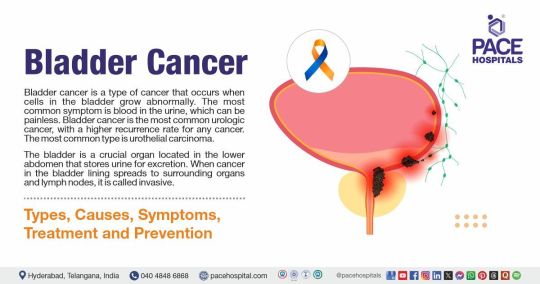
0 notes